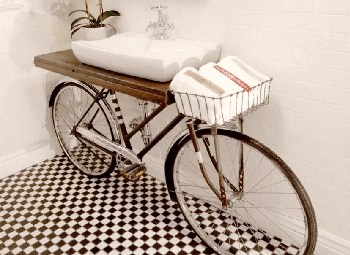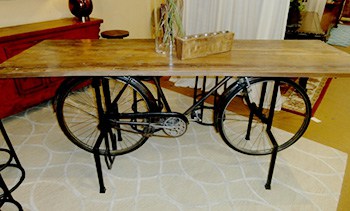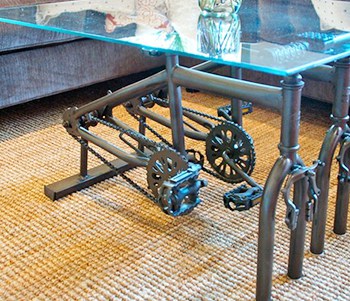
With the craze always being around the latest and greatest mountain bikes, I sometimes wonder what happens with all of the old mountain bikes. What kinds of things do people do with their old mountain bikes?
You’ve loved them, cherished them, and conquered some amazing epic rides together with your old mountain bike! But now, it’s time to move onto your new bike. So what should you do with your old one?
Let’s take a look at 7 things that you can do with an old mountain bike!
#1 Convert it to an e-bike
So, you’ve got an old mountain bike but aren’t quite ready to retire it? Have you thought about doing something out of the ordinary like converting it to an e-bike?!
E-bikes are a blast, but purchasing a new one can be very pricey. Using your old mountain bike as the basis for an e-bike will help to drastically cut down the cost. While many are quick to look down upon e-bikes, they can really fun! It’s hard to argue against a new fun way to have fun on your bike 🙂
Tired of slogging your way up long climbs only to quickly fly down and start over? Well, an e-bike could ease much of the climbing work for you and let you spend more time enjoying those fun downhill sections. If you’re using it for running errands, it will also drastically speed up your ride.
Let’s face it, neither you nor your “old” bike is getting any younger. It won’t hurt to sometimes let an engine provide a little extra assistance. E-bikes can help re-open trails for you that you haven’t had the fitness to previously tackle. You’re also still going to be doing plenty of pedaling, so don’t think that you won’t still be getting a good workout in!
Converting your old mountain bike to an e-bike can also be a fun project. There are only some many times that you can swap drivetrain components, re-run cables, etc… before the process gets old.
Lastly, consider the fact that converting your existing old mountain bike to an e-bike is MUCH cheaper than buying one. Thanks to their growing popularity, the price of e-bike conversion kits is dropping every year. Just make sure to purchase a mid-drive motor kit to ensure that you don’t have problems on hills.
Bafang is one of the biggest names in the conversion kit industry. You can even purchase them on Amazon at this point. While conversion may seem like a complex process, there are really only two components you have to worry about. The drive unit and battery. Simply hook them up, mount them, and you’re off riding!
If you’re interested in doing one, I’d recommend taking a look at this e-bike conversion kit by Bafang at Amazon.com. It comes in many options to fit your bike as well as all of the necessary mounting accessories.
For a detailed guide on how to do a conversion, make sure to take a look at my full article here.
#2 Put it to a good (new) use
Is this one of your favorite mountain bikes of all time? Is it an ancient relic that’s more antique than bike at this point? Regardless of the situation, there are certainly cases where we simply just don’t want to part ways with an old mountain bike.
Rather than letting it sit in the garage or shed out of sight collecting dust, how about putting it to good use! Not by riding it, but by turning it into a piece of furniture or art! With a little work, there are lots of ways to turn your cherished bike into a focal piece.
Thanks to their long shape, a bike can easily be converted into an end or dining table. Add a few legs for balance, and then mount a hard top to the seat post and handlebars. Naturally, you’ll need to do a few other things to secure it in place. But the final outcome can be quite chic! Not to mention the fact that you will have now have a one of a kind piece of furniture! Plus it still celebrates the legacy of one of your favorite bikes.
A little knowledge of metal and woodworking will be extremely helpful. However, these should be a pretty simple and fun project to take on. As long as you have a good idea of what you want, you can enlist the services of some local handymen to assist with the portions that are outside of your current skillset. Better yet, you could use this as an opportunity to learn a new skill!
Below are a few examples of tables that I found made from bikes for points of inspiration. I found the bike sink to be a particularly creative way to repurpose a bike!



#3 Donate it to a charity
If you’ve just upgraded to a fancy new bike and have no need to keep or sell your old mountain bike, then I’d highly recommend that you consider donating it. Mountain biking is an expensive hobby. The cost of purchasing a bike prevents many who are less fortunate from having a chance to enjoy it.
As long as the bike isn’t in terrible shape, there will be a long list of people who would be happy to put it to good use. Doesn’t the thought of someone else getting as much enjoyment out of the bike as you did bring some comfort in parting ways with your old bike?
On top of that, used bikes rarely sell for a large percentage of their original value. The joy you get from being able to make someone’s day may be worth more than the value of the bike itself.
General charity centers like Goodwill and Salvation Army are available nationwide (in the US) and will accept bikes in working condition. There are also fantastic bike-specific non-profit organizations. They solely focus on recycling and redistributing bikes to shelters, housing projects, and schools.
It would be impossible for me to provide and maintain a list of these non-profits. So you’re better off performing a simple web search for “bike donation programs near me”. This will help you locate options that are close by.
Certain services like pickupplease.org will even come to your house to get the bike.
However, I think it’s always best to check for a bike-specific group first. They will be better equipped to make any repairs to the bike (if needed) before finding it a new home.
Last but not least, by donating your bike you’re also eligible for a tax deduction. So if you didn’t get a warm fuzzy feeling from donating your old bike, you will at least be getting a tax break from Uncle Sam!
#4 Revitalize it with component upgrades
How old is the mountain bike?
If it’s only a few years old and has been decently maintained, then you can absolutely make some upgrades to keep it ride-worthy. Sure, it may not be your primary mountain bike but it’s always good to have a backup or specialty-use bike.
It may be that this is a hardtail bike, and your new/current bike is a full suspension. Keeping the hardtail around can be great for practicing your riding technique instead of always relying on the suspension. Not to mention the fact that a hardtail is easier to bunny hop 😉
Knowing that everyone’s budget and appetite to spend money on a backup bike will vary, I’ve broken down the upgrades into a few categories.
- Cheap upgrades: Less than $100
- Mid-range upgrades: $100 – $500
- High-end upgrades: Over $500
Keep in mind that these are rough ranges. However, they should give you a decent idea as to what you’ll find in each range.
Cheap upgrades ($)
Just keep in mind that most of these upgrades won’t play a large factor if you do eventually decide to sell the bike. So it makes sense to start with the easy and cheaper upgrades that will enhance your ride.
The pedals, grips, tires, chain, and saddle are all great places to start. You should be able to find all of these items under $100 each respectively.
In particular, fitting the bike with a fresh set of pedals and tires is a great way to start. Since this likely isn’t your primary bike, feel free to have fun installing some specialist components. Maybe the pedals are extra wide so your feet have more room wiggle room during tricks.
Perhaps the tires are extra aggressive for ultimate traction and grip. There’s really no need to worry about putting generalist equipment in place since this can be your fun bike. Well, they’re all fun. Just more so in this case 🙂
Mid-range upgrades ($$)
More expensive upgrades like the getting wider carbon handlebars or a shorter carbon stem are also great ways to improve the bike’s handling and ride quality. If you’re not sure why this would be the case, make sure to spend some time reading through my dedicated articles on mountain bike handlebar width and stem selection.
These upgrades will be a little bit pricier than the previous ones, especially if you go the carbon route. Regardless, they’re definitely going to improve the ride.
Dropper posts are another modern splurge that your older mountain bike likely doesn’t have. They allow you to dynamically raise and lower your seat while riding without needing to stop.
This is particularly helpful when you want to lower your center of gravity for a descent, but don’t want to interrupt your ride’s flow to do so. These upgrades can run anywhere from $150 – $500.
While dropper posts are for comfort, refreshing the bike’s brakes could be a good choice for safety reasons. Your brakes are quite literally the only things saving you from riding off the side of a mountain.
It’s not an area you want to cheap out on. Similar to dropper posts, they’re in the mid-range price point of approximately $250 – $500 for a full setup.
High-end upgrades ($$$)
If the bike is on the older side, you may want to consider swapping out the entire drivetrain. Chances are that it’s running a 3x setup and would stand to benefit from a more modern 1x drivetrain. Not only will this help you drop some weight, but you should also get some improved components in the process.
Depending on how nice your new drivetrain is, this may also fall into the “mid-range” price category. However, I’m assuming that you’ll be wanting to go with a decent groupset that will drive the cost into the high-end category.
In the event that you plan on taking this bike through some rough terrain, then you may want to look into upgrading the fork.
New forks often offer better dampening properties so that the trail isn’t pounding away at your limbs so much. They often also offer more adjustment options so that you can dial in the exact amount of dampening to the terrain.
Fork upgrades can get pricey very quickly, so if you have a small budget for component upgrades then this won’t be the place to start! You can hit the $500 mark very quickly, with some high-end forks going over $1,000.
Keep in mind that you can’t go completely crazy with a new fork. It still needs to work within the confines of your frame’s geometry, so the amount of travel you can add won’t be huge.
Last but not least, wheels are another area you may want to look into upgrading. If your plan is to put some wide beefy tires on the bike, then this may be a required upgrade as well to support the wider tires.
For more details on how tire width relates to rim width, you can refer to my article here on the topic.
In addition to fitting your tires, you may also choose to upgrade the wheels to save weight or for added stiffness. Heavier wheels are harder to rotate and may be less advantageous for cross-country riding.
Like forks, there is a large range to the price of new wheels. While new ones can be had in the ~$200 range, you’ll find that many starts around the $500 mark.
Some even go all the way up to $2,400!
In my opinion, it’s probably not worth investing thousands of dollars into the wheels on an older bike, but that choice is up to you.
#5 Convert it a gravel bike
If converting your old mountain bike to an e-bike seemed like too complicated or expensive of a project then a gravel bike could be a good bet.
Older bikes may be past their prime days of true off-roading, but that doesn’t mean that they aren’t up to the task of cruising down some smooth dirt or gravel trails.
You could almost think of it as using your old mountain bike as a hybrid, without needing to buy a new bike (win-win). While you can absolutely hop on the bike and start using it for gravel right away, there a few quick changes that you could make to get the most out of it.
The first and most obvious swap to make is for less aggressive tires! You won’t be needing all of that traction, and frankly, it’s only making you work harder to get around on smooth roads.
One of the next biggest limitations may be the bike’s gearing. Many modern mountain bikes only come with single front chainrings. While this is usually fine in mountain biking, you may find that you lack enough range to avoid spinning out.
Bikes with two or three front chainrings won’t have this problem, but you may want to consider upgrading your 1x drivetrain to a 2x or 3x version to avoid spinning out.
Lastly, the addition of bar ends will probably be a good choice to provide your hands and arms with more positions for comfort. This will also help you to maintain a more aerodynamic shape during rides to maximize efficiency.
If optimizing your mountain bike for gravel rides is of interest, I’d recommend taking a look at my dedicated article on this topic.
#6 Use it as a commuter
While converting your old mountain bike into a gravel beast may not be of interest, using it as a daily commuter or for running errands may be more appealing.
Also like a gravel bike conversion, optimizing it for commuting should be much cheaper than buying a new road or hybrid bike.
Rather than wearing down your good trail tires riding into work or running errands, you can choose to use your old bike with a set of narrower, slicker tires. Like with the gravel bike, using smoother bikes will make your ride a bit more effortless.
While it may seem a little goofy, you can also choose to add fenders or a cargo rack. These can be really handy when transporting items on your bike.
#7 Sell it
The last and most obvious choice for any old mountain bike is to try and sell it. If you’ve already got a new mountain bike and the old one is still in decent working condition, then it makes sense to pass it on to someone else who can enjoy it more.
To get the most out of selling your old bike, you’ll want to get it serviced to ensure that it’s fully ready for the new owner to enjoy it. Otherwise, getting someone to pay for an old, non-working mountain bike isn’t going to be an easy task. Or if they do, you likely won’t be able to recoup much of the money that you put into it.
Unfortunately, even in a best-case scenario, used mountain bikes don’t hold their value very well. After the first year or two, there’s a very sharp fall off in the bike’s original value.
If you’re interested in seeing how used mountain bikes hold their value, take a look at my dedicated article on the topic. In this article, I cover the ins and outs of mountain bike depreciation.
